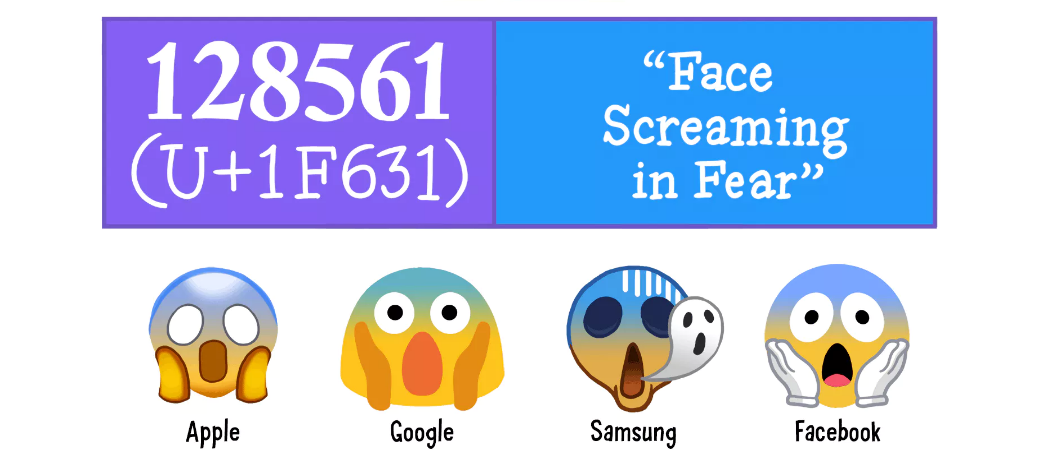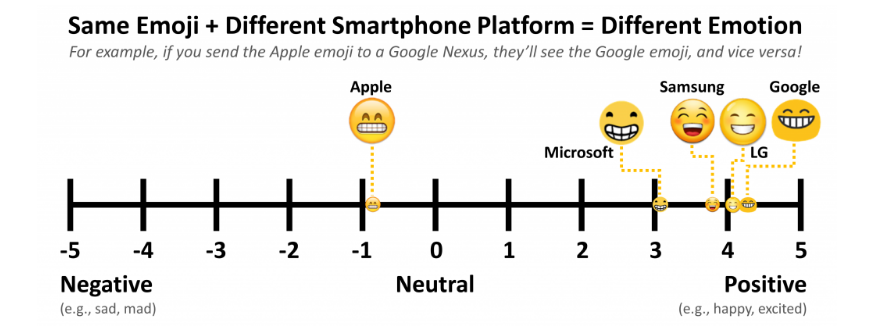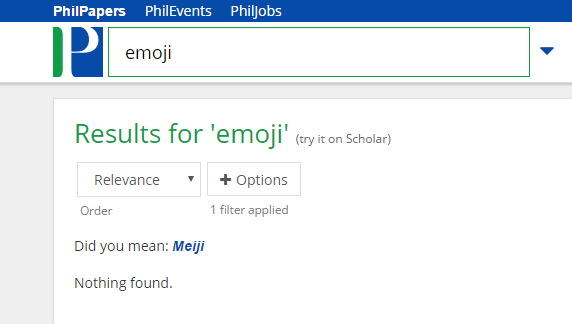
screenshot from the comic “Want A New Emoji?” by Andy Warner
[Note: An updated, more detailed version of this post was published as “A Plea for Emoji” in the American Society for Aesthetics newsletter.]
Some Philosophical Questions about Emoji
First, let’s be clear about what we’re talking about. “Emoji(s)” are things like this: [😀🤔], not emoticons like : ) or (T_T) or ¯\_(ツ)_/¯ or ㅇㅅㅇ. (Note: in this post, emoji will be flagged by square brackets so that if you can’t see them, you’ll at least know roughly what you’re missing.)

Thank you, Wikipedia
A Brief History of Emoji:
- introduced in 1995 by Japanese telecom company Docomo
- first emoji: ❤
- then, another 175 followed
- 2011: Apple introduced them…
- soon after, everyone else did too
See the awesome comic “Want a New Emoji?” by Andy Warner and this Vice video for more.
Now, some philosophical questions about emoji and my unsupported hot take on the answers.
Metaphysics
Are the different Apple-Google-Samsung emoji different emoji instances or genuinely different emoji? What is an emoji?
I guess the different emoji in the first image are probably just instances of one emoji, since emoji are individuated by their Unicode numbers and coarse-grained descriptions (like “Smiling Cat Face with Heart-Shaped Eyes” or [😻]). But then, the emoji isn’t itself just the number or just the description. Emoji are pictographs and Unicode numbers are not pictographs, nor are descriptions. So emoji need a particular pictographic manifestation.
Maybe it’s a type-token relationship or a determinable-determinate relationship. I bet it’s like whatever we call the relationship between a piece of music and its score. … Maybe. I have no idea; I don’t really do metaphysics.
Whatever we say, this seems pretty important:

from “Investigating the Potential for Miscommunication Using Emoji“, a computer science and engineering study by Hannah Miller
Also, is : – ) the same as : ) ? Are these the same as (^_^)? And are these the same as ☺ and [😊]?
Yes, no, no. Or maybe: yes, yes, yes. But definitely not: no, yes, yes.
Language
Do emoji have semantic content? Can a string of (only) emoji be propositional? Are emoji words? Do they constitute a bona fide language?
Yep, I’m going to say they definitely have semantic content, although they are also used as a kind of prosody (e.g., to indicate sarcasm or other emotional punctuation). And sure, a string can be propositional. Here are two easy one-emoji string examples: [👍] or [🤝] = Sounds good, Okay, Deal. That said, it’s probably underdetermined in most cases, and most strings are, like all emoji, going to be highly subject to context, as well as idiolect or dialect variation.
Emoji can function as nouns (I want [🍕]) or verbs (I [❤] you) or interjections ([😲])… etc. Are they words? Well, I don’t know really what a word is, but Oxford Dictionaries* seems to think so, so let’s say yes.
The poverty of dedicated – or even roughly standardized syntax (e.g., I bet word order emoji order varies between SVO and SOV languages) is going to make calling it a language – at least a standalone one – pretty difficult, though. And can a system be a language if it has to be parasitic on another, standalone language? I would have thought no, but I don’t know. Maybe this is a counterexample?
*[😂], “Face with Tears of Joy”, was named Oxford Dictionaries Word of the Year in 2015.
Now what?
Philosophers: really, NO results??

We need to get on this. I guess that, for now, I will have to content myself with Language Log archives and other random amusing things online. [😂😂😂]


April 6, 2017 at 2:47 pm
I have a paper where I argue that logical connectives are basically a kind of emoji/ emoticon. Each basic connective presents a perspective on how to view a certain situation, like a reaction emoji. Not holding my breath on getting it published, though……
April 7, 2017 at 8:48 pm
So you think ‘and’ and ‘or’ are like emoji? That would be pretty surprising! Connectives are more than just a perspective, right?
April 12, 2017 at 6:54 pm
It seems to me as if truth-functional connectives are the opposite of emoji. Connectives have an explicitly defined meaning, have a definite syntax, and leave out all the nuance. Emoji have no prescribed meaning, have no syntax, and are plump with nuance.
April 6, 2017 at 9:57 pm
Your brief history leaves out the incorporation of emoji into Unicode. That standardization makes a strong argument for the Apple and Android versions of [😬], for example, being instances of the same character. If I text to a friend using that emoji, I may not know what system they have. They can receive my message anyway, so long as they are displayed whatever counts as that emoji on their system.
As for the language issue, a related question is whether there is any English (or other natural language) translation for a string of emoji. In a work-in-progress paper, I argue that there isn’t. Recognizing this helps us better understand instances of emoji art, like emoji poems.
https://www.fecundity.com/job/paper.php?item=emojiart
April 7, 2017 at 8:45 pm
Yeah definitely! That’s actually why I thought of it as performances and a score – the Unicode standardization providing a sort of “score” for the particular emoji-instances.
As for the translation: sounds super interesting! Do you think that any languages (or whatever emoji constitues, if not a language) are like that? As in, not translatable into any natural language?
April 7, 2017 at 9:12 pm
I’m happy to allow that it is typically possible to translate from one natural language to another. The point doesn’t rely on Quinean meaning nihilism or anything like that. Rather, I think that there isn’t English-emoji translation in the same way that there is (for example) English-French translation.
I like the score:performance::code:display analogy.
April 7, 2017 at 9:33 pm
Yeah that makes sense – I was thinking more like, are there other symbolic languages that might be like emoji in that way. Maybe like coding languages or something.
April 6, 2017 at 11:15 pm
Ye Tian, a linguist at Paris Diderot, is doing some pioneering work on the abovementioned language questions, such as:
https://docs.google.com/viewer?a=v&pid=sites&srcid=ZGVmYXVsdGRvbWFpbnx5ZXRpYW5saW5ndWlzdGljc3xneDoxMTMzNGQ3ZWEyMjZjZjlm